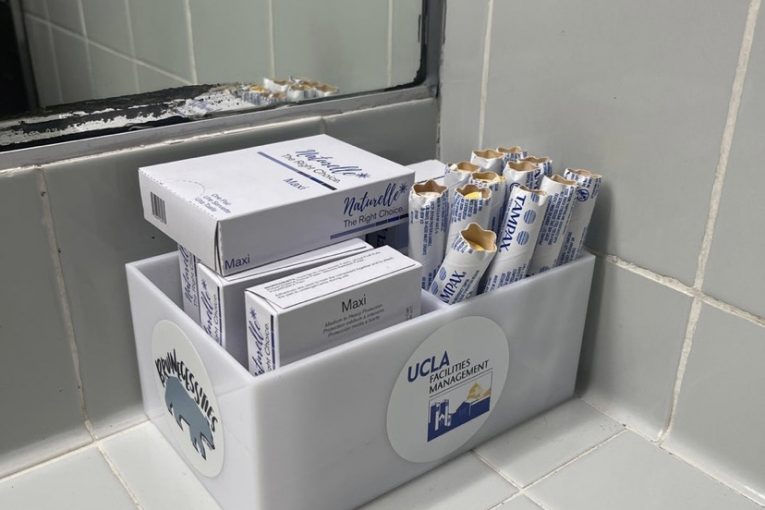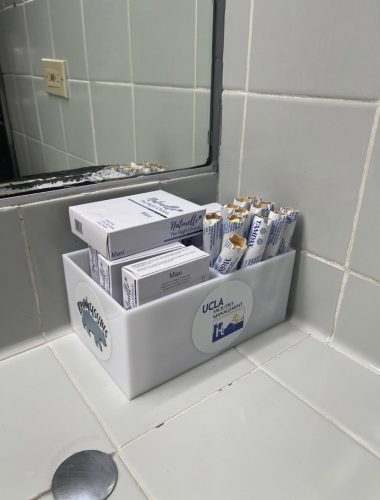

By Sara Biakanja
On March 17, the Bruin community received an official email from UCLA’s Facilities Management entitled UCLA to Provide Free Menstrual Products in Campus Restrooms. In this email, the Facilities Management announced they will be supplying free and unlimited menstrual products available in restrooms across campus starting April 4. I must say it’s very impressive that, as the number one ranked public university, they continuously pave the way for excellence and new innovation. UCLA announced they are “the first institution in the University of California system to provide free menstrual products campus wide.” However, this “new effort” did not randomly occur and raises a lot of questions around student dignity and equity. On campus, student advocacy groups have been demanding that the university fulfills their obligation to support the needs of their students, including the well-being of providing free access to resources. Since 2017, the SWC Bra Necessities committee (part of UCLA undergraduate Student Association Student Wellness Commission) has initiated providing menstrual products to students. Additionally, the club Ignite at UCLA’s petition Ending Period Poverty at UCLA gathered over 1,700 signatures again urging an administrative change making menstrual products free and unlimited to all UCLA students. As a member of Ignite at UCLA, we questioned why the Ashe Center on campus provides students unlimited condoms, while people who menstruate are limited to one tampon or menstrual product. It’s a clear issue to me, as to many others who understand that one tampon is not enough.
I also urge readers to recognize that the current systems across universities and state schools disadvantaged students who cannot afford menstrual products, contributing to the vicious cycle of period poverty. Again, universities distribute unlimited and free condoms for their students; and yet it’s taken until 2022 for the first University of California to provide free menstrual products. Sex is optional, bleeding is not. When 1 in 10 college students struggle to afford panty liners, pads, tampons, and other menstrual hygiene supplies, the current structures of the educational system are failing to meet their needs. In fact, people who have menstrual cycles make up 60 percent of total enrollment in university and state campuses. Speaking from the perspective of a woman and student of the public school educational system from elementary to now, “women” bathrooms are extremely flawed and inconsistent in function and design. I have gone into many public restrooms, including on UCLA’s campus, where they do not even have tampon dispensers: those clunky mental boxes whose vending machine payment cost anywhere from .25¢ upwards to $1.25. If you are lucky enough to find a restroom with a tampon dispensary and have quarters on you, more than half of the time they are empty.
To those wondering, why is UCLA including menstrual products available in men’s and gender-neutral bathrooms, why not just women’s bathrooms if they’re the ones bleeding? What’s the point for men and gender-neutral bathrooms to even have menstrual products? By making available menstrual products in those bathrooms, it includes accessibility for LBGQT+ members, specifically transgender, non-binary, and gender-fluid people, who still routinely have menstruation cycles. This “new effort” by the university is a step forward in the right direction but by no means is this work done, as marginalized groups are continuously subject to discrimination and targeted polices. Another reason to include menstrual products in restrooms across campus is the opportunity to reduce the stigma that surrounds periods, tampons, pads, etc. For example, I see the convenience of having your friend or even student peer carrying them around and helping out each other when in desperate need of a menstrual product. I have seen multiple times in stores boxes of tampons costing $12.49, a box of pads cost $10.89, forcing millions of college students to have yet another additional cost to their living while already spending multi-thousands of dollars for lectures, rent, food, books, utilities, etc. According to The Faculty Lounge report, How Much Do “Free” Tampons Cost? #MenstrualCapitalism and Examples from New York State, a whopping $29 per year per student. I know for a fact universities and state school’s financial budgets can be re-structured in a way that includes those costs. I also know from an educational standpoint most men don’t typically think about periods, or tampons, or how those two things work together, or if they’ve even seen a menstrual product in their life. I see this as an opportunity to bridge the gap between a lack of awareness many people endure around menstrual products, while embracing the fact their peers use such products, have periods, and that they can be an ally.
There has been momentum towards eliminating period poverty in recent legislation, such as California’s Menstrual Equity for All Act of 2021 which UCLA email said, “advises universities to stock 50% of their restrooms with an adequate supply of free menstrual products.” The statement continues on how “UCLA is going above and beyond the recommendation—making the products available in men’s, women’s, and gender-neutral restrooms.” I do hope they live up to this. While reading the Assembly Bill No. 367, it turns out, “The California Constitution requires the state to reimburse local agencies and school districts for certain costs mandated by the state. Statutory provisions establish procedures for making that reimbursement […] if the Commission on State Mandates determines that the bill contains costs mandated by the state, reimbursement for those costs shall be made.” I interpret this information as the university could be rolling out these products free of charge and organizing designated areas in restrooms to provide these products; which UCLA in some locations has started doing. I’ve seen some of these menstrual product “stations” in restrooms, however, they more closely resemble a pencil and pen holder and again run into the issue of being empty. In addition, in the Powell reading room section I saw on the table tampons and pads—yet no container or sign and just the original packaging that it comes with in. Overall, I am optimistic that UCLA will continue to work with student committees like SWC Bra Necessities in creating an efficient rollout plan that ensures the standards are continuing to uplift Bruins; creating a standard of excellence other Universities of California, state, private and community colleges can follow. I’m excited to have been a part of raising awareness for the need of free, accessible, and unlimited menstrual products for students.